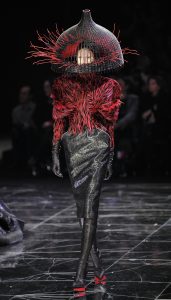Another dress, designed for the wife of a software CEO, rose three stories high and was attached to the back of the house by a covered walkway.
“A Change in Fashion,” in true Millhauser style, is written as an historical account of a future time, which, we find out at the end of the story, has already passed in its entirety. Millhauser again uses exaggeration as his element of the fantastic, this time in the development of fashion to a place where its wearers are rendered almost obsolete. This concept of fashion independent of its wearer is fascinating and hilarious. Such wild exaggeration is cause for amusement, and I do not think that Millhasuer truly expects his readers to believe such a time would ever happen. One wonders how society could reach the point where a dress takes up a city block and becomes its own sort of architecture. I personally find it all ridiculous. I also wondered how everyday people thought about this fashion as it seemed like more of an haute couture trend than something practical. Overall, this story raised a lot of questions for me about how the entirety of this future hypothetical society would have functioned and if only the rich women could afford to “escape.”
